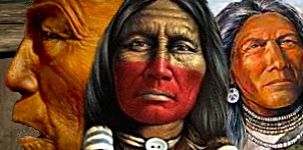 |
|
 |
|||
 |
 |
 |
 |
||
|
|
|||||
      |
cherokee pharmacopoeia
|
Artifact Replicas|Jewelry|Clothing|Figurines|Art Prints|On Sale|Closeouts
Custom Search
What's New Cherokee pharmacopoeia of medicinal plants and herbal remediesThe botanical diversity in Western North Carolina is extensive; it is estimated that in times past the average ani yvwiya would have been familiar with 100-200 plants and a medicine priest (didahnewisgi) might know as many as 600 useful plants. From this tremendous quantity of available plants, many commonly used Cherokee medicines made their way into American medical practice. We can thank the Cherokee and othe rEastern native peoples for introducing many of our most popular botanical remedies. While many useful plants became widely used by herbalists and physicians, others were underutilized or totally neglected. Today, many herbalists limit their materia medica to a small variety of herbs. This over-reliance on a few plants has contributed to the decimation of many wild plant populations. (i.e. Ginseng,Ladies Slipper, Goldenseal, Bethroot, and more recently Echinacea angustifolia, Lomatium, and Helonias). Are we using these plants with respect? The Cherokee use a great variety of medicines not only to prevent overutilization of species, but also because they believe that every plant has its specific use in relationship to human ailments. Contributions Towards a Cherokee PharmacopoeiaEach plant in this obviously partial listing is an effective medicine and, equally important, is abundant throughout large areas of the U. S. or is easy to cultivate. BALMONY (Chelone glabra) Taste: bitter Energy: cool, dry Part Used: herb Dosage: Herb tea: 1 tsp. dried herb to 8 oz. of water, steep 1 hour. Drink 4 oz. before meals. Dosage: Extract: 30-40 drops, 3 times per day. Western classification: aperient, anthelmintic, bitter tonic, cholagogue. Balmony or Turtlehead is a beautiful herb with either white or pink flowers (C. lyoni). It grows in damp deciduous woods and is frequently found along side of small branches (creeks). Balmony is an effective digestive bitter: stimulating saliva, gastric, liver and gall bladder secretions. It is especially useful for people with poor fat metabolism, usually accompanied by gas, nausea, belching and a chronically sluggish bowel. Associated skin problems ( psoriasis, eczema or acne) and non-hepatitis jaundice respond to its effects as well. Mixed with other anthelmintics (Elecampane, Garlic, Wormseed, Quassia) it is useful in treating pinworms andgiardia. DOGWOOD (Cornus florida) Taste: bitter Energy: cool, dry Part Used: bark, flower, berries Cherokee Name: kanvsita Western Classification: anodyne, antiperiodic, antispasmodic, astringent, bittertonic. Dosage: Bark tea: 1/2 tsp. dried bark to 8 oz. of water. Decoct 15 minutes, steep 1/2 hour.Drink 4 oz. 3 - 4 times per day. The Dogwood is a small shrubby tree, with lovely early spring flowers. The white flowers (they areactually sepals) have been used as a substitute for Chamomile for colds, colic and flu. The bark was once used similarly to quinine for malaria and other periodic fevers. It is still useful for many chronic fevers, especially if accompanied by diarrhea or muscle aches (Dengue fever). Lower back pain, prolapsed uterus and musclespasms (legs and feet) all respond to regular use of the tea. Mixed with Butternut Bark, Dogwood is effective for pinworms in children. Externally the bark poultice can be used as a wash for bed sores and ulcers. DWARF GINSENG (Panax trifolium) Taste: sweet, bitter Energy: cool, moist Part Used: root, leaf Cherokee Name: yunwi usdi Western Classification: adaptogen, carminative, nutritive. Dosage: Leaf tea: 1 tsp. dried leaf to 8 oz. of water, steep 1 hour. Drink 2-3 cups per day. The small, delicate Dwarf Ginseng is a common spring ground cover in Eastern deciduous woods. The small bulbs are edible (rather bland and starchy) and can be cooked in winter stews to strengthen the lungs and resistance to colds. The leaves (which contain Ginsenosides) are added to almost any traditional herb formula to increase its effectiveness and activity. The Dwarf Ginseng, like its larger relative, is used for fatigue, nervous exhaustion, allergies, anorexia and depleted conditions such as chronic fatigue, TB and mononucleosis. RABBIT TOBACCO (Gnaphalium obtusifolium) Taste: sweet, bitter Energy: cool, dry Part Used: herb Cherokee Name: katsuta equa Western Classification: astringent, carminative, diaphoretic, expectorant,nervine. Dosage: Herb tea: 1-2 tsp. dried herb to 8 oz. of water, steep 40 minutes. Drink 2-3 cups per day. Common in fields and clearings, Rabbit Tobacco is frequently found in Cherokee homes as a remedy. The tea is used for colds, flu, coughs, diarrhea, strep throat and children's fevers. Mixed with other medicines it is also used for colitis (with Wild Yam and Catnip), asthma (with Lobelia, Wild Cherry Bark and Sweet Cicily) and vaginal candidiasis (with Yellow Root). Externally the tea is applied to cuts, sore muscles and bruises.The leaves are chewed by some people in preference to Tobacco, others mix the two to moderate Tobacco'semetic qualities. SOURWOOD (Oxydendron arborum) Taste: sour Energy: cool, dry Part Used: leaf Cherokee Name: udoqueya Western Classification: antiseptic, astringent, diuretic, nervine. Dosage: Leaf tea: 2 tsp. dried leaf to 8 oz. of water, steep 40 minutes. Drink 2-3 cups per day. Sourwood with its racemes of white bell-like flowers is a favorite pollen source for mountain bees. The honey from this source is famous for its unique taste and fragrance. In contrast to the honey's sweetness, the leaves are tart and drying. The leaf tea is an effective urinary tract antiseptic primarily due to its arbutin content. Chronic UTIs with burning urine respond well to its soothing action; it is also beneficial for BPH. The tea is also frequently used for apthous stomatata, thrush, edema, chronic prostatitis, diarrhea, nervous stomach and frazzled nerves (a nice hot cup of the tea with a generous dollop of sourwood honey works wonders!). SPICEBUSH (Lindera benzoin) Taste: pungent, sweet Energy: warm, dry Part Used: bark, leaf, fruit Cherokee Name: nodatsi Western Classification: antiseptic, carminative, diaphoretic, emmenagogue,expectorant. Dosage: Bark/Herb tea: 1 tsp. dried herb to 8 oz. of water, steep 1 hour (covered).Drink 2 -3 cups per day. Spicebush is one of the most common understory shrubs throughout second or third growth Eastern forests. Early in the spring it is covered with small yellow flowers which perfume the air. Every part of Spicebush (aka Spicewood) is medicinal; the tea of this herb is used extensively for colds, flu, coughs, nausea,indigestion, croup, flatulence and amenorrhea. The inhaled steam is used to clear clogged sinuses and the decoction of the twigs makes a soothing bath for arthritic pain (some of the tea is also taken internally). Spicebush is also commonly used as a beverage tea and the fruits can be used as a spice in baking. SUMACH (Rhus glabra, R. copallina, R. typhina) Taste: sour Energy: cool, dry Part Used: berry, bark Cherokee Name: qualagu Western Classification: alterative (bark), antiseptic, astringent, diuretic. Dosage: Berry tea: 1 tsp. dried fruit to 8 oz. of water, steep 30 minutes. Drink 2 - 4 cups per day.Bark tea: 1/2 tsp. dried bark to 8 oz. of water. Decoct 15 minutes, steep 1 hour. Drink 4 oz., 3 times per day. Sumachs are small shrubby trees that have highly visible clusters of bright red berries each autumn. Its toxic relative Poison Sumach (R. vernix) has white fruit and prefers swampy areas instead of the dry open environment where other sumachs are found. Sumach berry tea is highly effective for urinary tract infections (itacidifies the urine), thrush, apthous stomatata, ulcerated mucous membranes, gingivitis and some cases of bedwetting (irritated bladder). The fruit tea can be taken hot or chilled as a refreshing beverage similar in taste to Hibiscus or Rose Hips. The bark is a strong astringent (used for diarrhea, menorrhagia) and it has an effect onthe female hormonal system. Traditional the bark is used for alleviating menopausal discomfort (hot flashes,sweating) and as a galactogogue. Externally the berry or bark tea has been used as a wash for blisters, burns and oozing sores. In middle eastern countries, the dried fruit is ground into a powder and used much as Americans use paprika in daily cooking. SWEET CICILY (Osmorhiza claytoni) Taste: sweet Energy: warm, moist Part Used: root Western Classification: carminative, demulcent, expectorant, immune tonic, nutritive. Dosage: Root tea: 1 tsp. dried root to 8 oz. of water. Steep 2 hours (cooking 3-4 hours is evenbetter). Drink 2-3 cups per day. Sweet Cicily is a small herbaceous member of the Apiaceae family. Growing in moist woodlands, it is easy to overlook until you sample its sweet anise-tasting root. Cherokee have long considered this root to bean important medicine for increasing strength, weight and resistance to disease. The tea can be used for colds, sore throats, dry coughs, flu and digestive disturbances (gastritis, nausea, gas). Sweet Cicily strengthens what the Chinese call the "wei qi", making it useful for preventing colds and other external pernicious influences.The root can be used as a substitute for licorice or astragalus with many similar applications. TULIP TREE (Liriodendron tulipifera) Taste: bitter Energy: cool, dry Part Used: bark Cherokee Name: tsiyu Western Classification: anodyne, astringent, bitter tonic, febrifuge. Dosage: Bark tea: 1-2 tsp. dried bark to 8 oz. of water. Decoct 20 minutes, steep 1 hour.Drink 4 oz. 3 times per day. Tulip Tree or Tulip Poplar is a large, straight growing member of the Magnolia family. Its yellow, green and orange flowers are large and showy and they mature into a densely packed cone of winged seeds. The smooth young bark harvested in the spring makes a wonderful basket perfect for gathering herbs or berries. This same bark is used as a medicine for periodic fevers, diarrhea, pinworms, as a digestive aid and for rheumatic pain. The decoction is used as a bath for fractures, sprains, hemorrhoids and is applied to snakebites received in dreams (if left untreated, traumatic arthritis will often develop in the area bitten). YELLOW ROOT (Xanthorhiza simplicissima) Taste: bitter Energy: cool, dry Part Used: root Cherokee Name: dalanei Western Classification: antibacterial, antifungal, antiseptic, bitter tonic,cholagogue. Dosage: Root tea: 1-2 tsp. dried root to 8 oz. of water. Decoct 10 minutes, steep 1 hour.Drink 2 cups per day. Extract: 20-40 drops, 2-3 times per day. Yellow root is a shrubby berberine containing plant that is found growing along branches and springs.It is abundant throughout the southeast and is regularly substituted for the increasingly scarce Golden Seal. Xanthorhiza is milder than Hydrastis but is more appropriate for long term use. It is especially effective as a digestion/liver bitter for people with sluggish bowels, a tendency towards hemorrhoids and faulty fat digestion. Mixed with fresh Black Walnut hull extract and Spilanthes, Yellow Root is an effective treatment for local thrush,(vaginal candidiasis) and systemic candidiasis. The tea makes a soothing gargle for strep throat,apthous stomatata, ulcerated mucus membranes, herpes and pyorrhea. Externally it is useful for conjunctivitis, bedsores, bleeding hemorrhoids, ringworm and athletes foot. This page is presented for informational purposes, only. It is not intended to diagnose or treat any specific illness. We are not doctors. You should seek out qualified medical personel if you need help with a particular condition or illness. 
North American Indians Art Print Currier & Ives 22.0625 in. x 28 in. Buy at AllPosters.com Framed Mounted |
|
||||||||||||||||||||||||||||||||||||||||||||||||||||||||||||||||||||||||||||||||||||||||||||||||||||||||||||||
| ||||||||||||||||||||||||||||||||||||||||||||||||||||||||||||||||||||||||||||||||||||||||||||||||||||||||||||||||
Site Designed by: Mazaska Web Design
Hosted by: HostIt4You.com
© 1999-2008 AAANativeArts.com
+1131
file: cherokee pharmacopoeia

